Analyzing IKEA's Supply Chain Challenges & Improvement Strategies
VerifiedAdded on 2023/06/11
|17
|4399
|60
Report
AI Summary
This report examines the supply chain management of IKEA, a multinational company with a vast network of stores and distribution centers. It identifies key challenges the company faces, including sustainability, maintaining low product costs, and implementing a centralized planning process. The report delves into issues such as waste management, rising oil prices, and inconsistencies in data synchronization. Furthermore, it discusses marketing challenges related to cultural diversity and expansion barriers in regions like South Asia. The report concludes by providing recommendations for IKEA to address these challenges, such as adapting product designs to local markets, developing tailored supply networks, and focusing on cost-effective solutions while maintaining quality and sustainability. This document is available on Desklib, a platform offering a range of study tools and solved assignments for students.
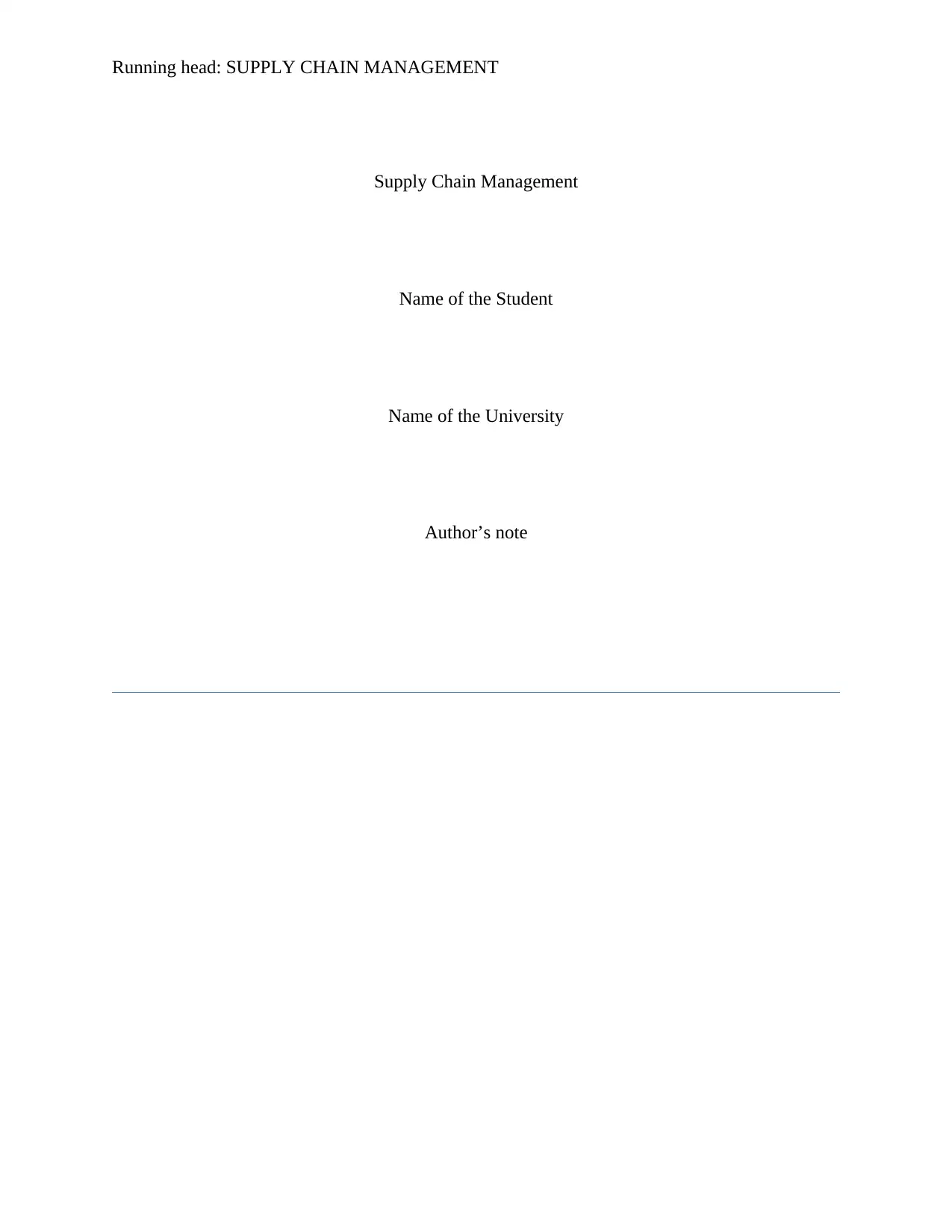
Running head: SUPPLY CHAIN MANAGEMENT
Supply Chain Management
Name of the Student
Name of the University
Author’s note
Supply Chain Management
Name of the Student
Name of the University
Author’s note
Paraphrase This Document
Need a fresh take? Get an instant paraphrase of this document with our AI Paraphraser
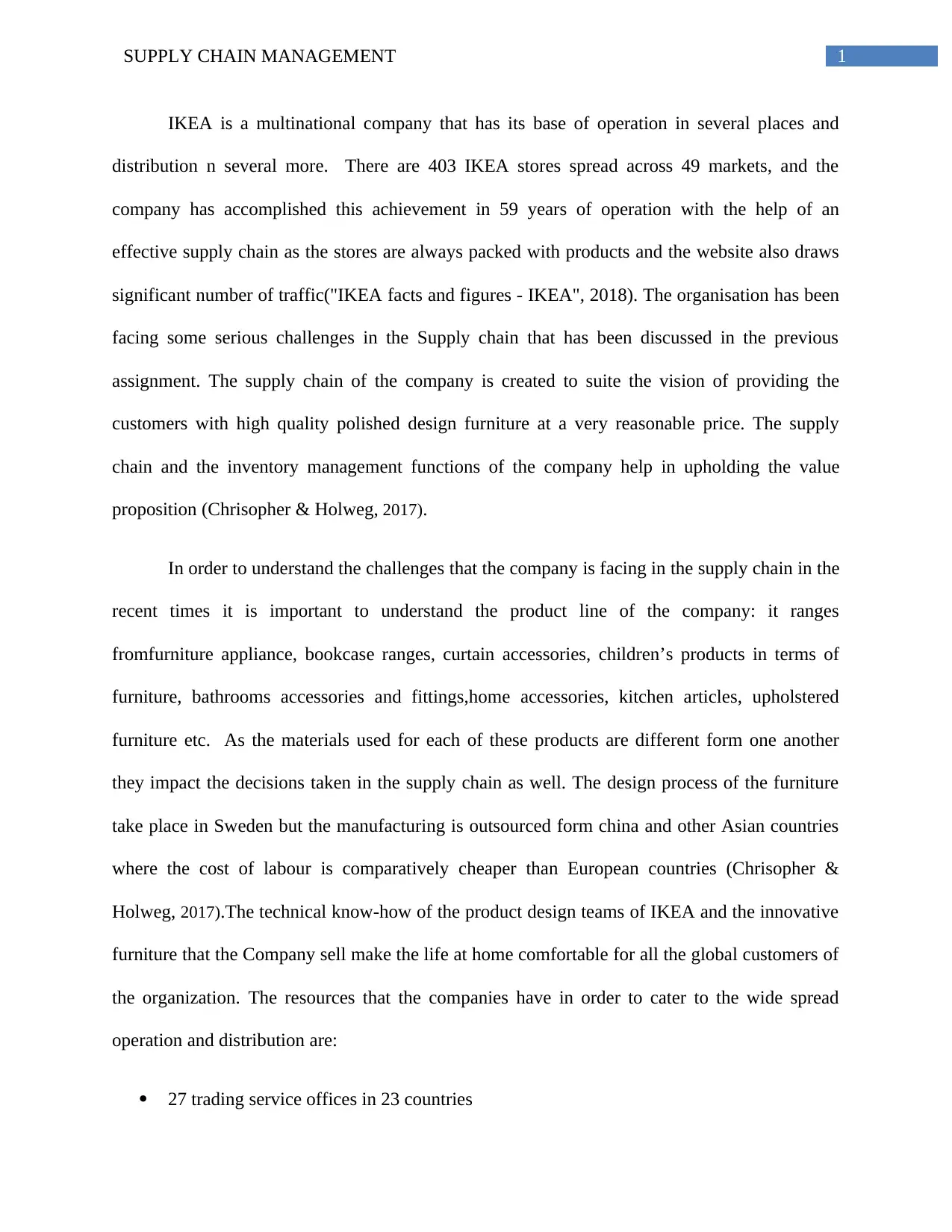
1SUPPLY CHAIN MANAGEMENT
IKEA is a multinational company that has its base of operation in several places and
distribution n several more. There are 403 IKEA stores spread across 49 markets, and the
company has accomplished this achievement in 59 years of operation with the help of an
effective supply chain as the stores are always packed with products and the website also draws
significant number of traffic("IKEA facts and figures - IKEA", 2018). The organisation has been
facing some serious challenges in the Supply chain that has been discussed in the previous
assignment. The supply chain of the company is created to suite the vision of providing the
customers with high quality polished design furniture at a very reasonable price. The supply
chain and the inventory management functions of the company help in upholding the value
proposition (Chrisopher & Holweg, 2017).
In order to understand the challenges that the company is facing in the supply chain in the
recent times it is important to understand the product line of the company: it ranges
fromfurniture appliance, bookcase ranges, curtain accessories, children’s products in terms of
furniture, bathrooms accessories and fittings,home accessories, kitchen articles, upholstered
furniture etc. As the materials used for each of these products are different form one another
they impact the decisions taken in the supply chain as well. The design process of the furniture
take place in Sweden but the manufacturing is outsourced form china and other Asian countries
where the cost of labour is comparatively cheaper than European countries (Chrisopher &
Holweg, 2017).The technical know-how of the product design teams of IKEA and the innovative
furniture that the Company sell make the life at home comfortable for all the global customers of
the organization. The resources that the companies have in order to cater to the wide spread
operation and distribution are:
27 trading service offices in 23 countries
IKEA is a multinational company that has its base of operation in several places and
distribution n several more. There are 403 IKEA stores spread across 49 markets, and the
company has accomplished this achievement in 59 years of operation with the help of an
effective supply chain as the stores are always packed with products and the website also draws
significant number of traffic("IKEA facts and figures - IKEA", 2018). The organisation has been
facing some serious challenges in the Supply chain that has been discussed in the previous
assignment. The supply chain of the company is created to suite the vision of providing the
customers with high quality polished design furniture at a very reasonable price. The supply
chain and the inventory management functions of the company help in upholding the value
proposition (Chrisopher & Holweg, 2017).
In order to understand the challenges that the company is facing in the supply chain in the
recent times it is important to understand the product line of the company: it ranges
fromfurniture appliance, bookcase ranges, curtain accessories, children’s products in terms of
furniture, bathrooms accessories and fittings,home accessories, kitchen articles, upholstered
furniture etc. As the materials used for each of these products are different form one another
they impact the decisions taken in the supply chain as well. The design process of the furniture
take place in Sweden but the manufacturing is outsourced form china and other Asian countries
where the cost of labour is comparatively cheaper than European countries (Chrisopher &
Holweg, 2017).The technical know-how of the product design teams of IKEA and the innovative
furniture that the Company sell make the life at home comfortable for all the global customers of
the organization. The resources that the companies have in order to cater to the wide spread
operation and distribution are:
27 trading service offices in 23 countries

2SUPPLY CHAIN MANAGEMENT
33 distribution centers and 15 Customer distribution centers in 17 countries
43 industry production units in 11 countries("IKEA facts and figures - IKEA", 2018)
Briefly, the supply chain of IKEA has the following steps procuring, storing, manufacturing,
and delivery processes. Following is a diagrammatic representation of the supply chain process
of IKEA (Christopher, 2016).
Figure: IKEA Supply Chain
(Source: Jonsson et al., 2013)
As IKEA’s mission is to provide the customers with ergonomically designed, purposeful,
low priced and sustainable furniture. With the help of the supply chain have over the years
successfully achieved the goal. Yet in the process of business function, there are
severalchallenges due to various reasons internal or external. The dynamics of the business
keep changing thus, the company has to renew policies and decisions to fit in the new
33 distribution centers and 15 Customer distribution centers in 17 countries
43 industry production units in 11 countries("IKEA facts and figures - IKEA", 2018)
Briefly, the supply chain of IKEA has the following steps procuring, storing, manufacturing,
and delivery processes. Following is a diagrammatic representation of the supply chain process
of IKEA (Christopher, 2016).
Figure: IKEA Supply Chain
(Source: Jonsson et al., 2013)
As IKEA’s mission is to provide the customers with ergonomically designed, purposeful,
low priced and sustainable furniture. With the help of the supply chain have over the years
successfully achieved the goal. Yet in the process of business function, there are
severalchallenges due to various reasons internal or external. The dynamics of the business
keep changing thus, the company has to renew policies and decisions to fit in the new
⊘ This is a preview!⊘
Do you want full access?
Subscribe today to unlock all pages.

Trusted by 1+ million students worldwide
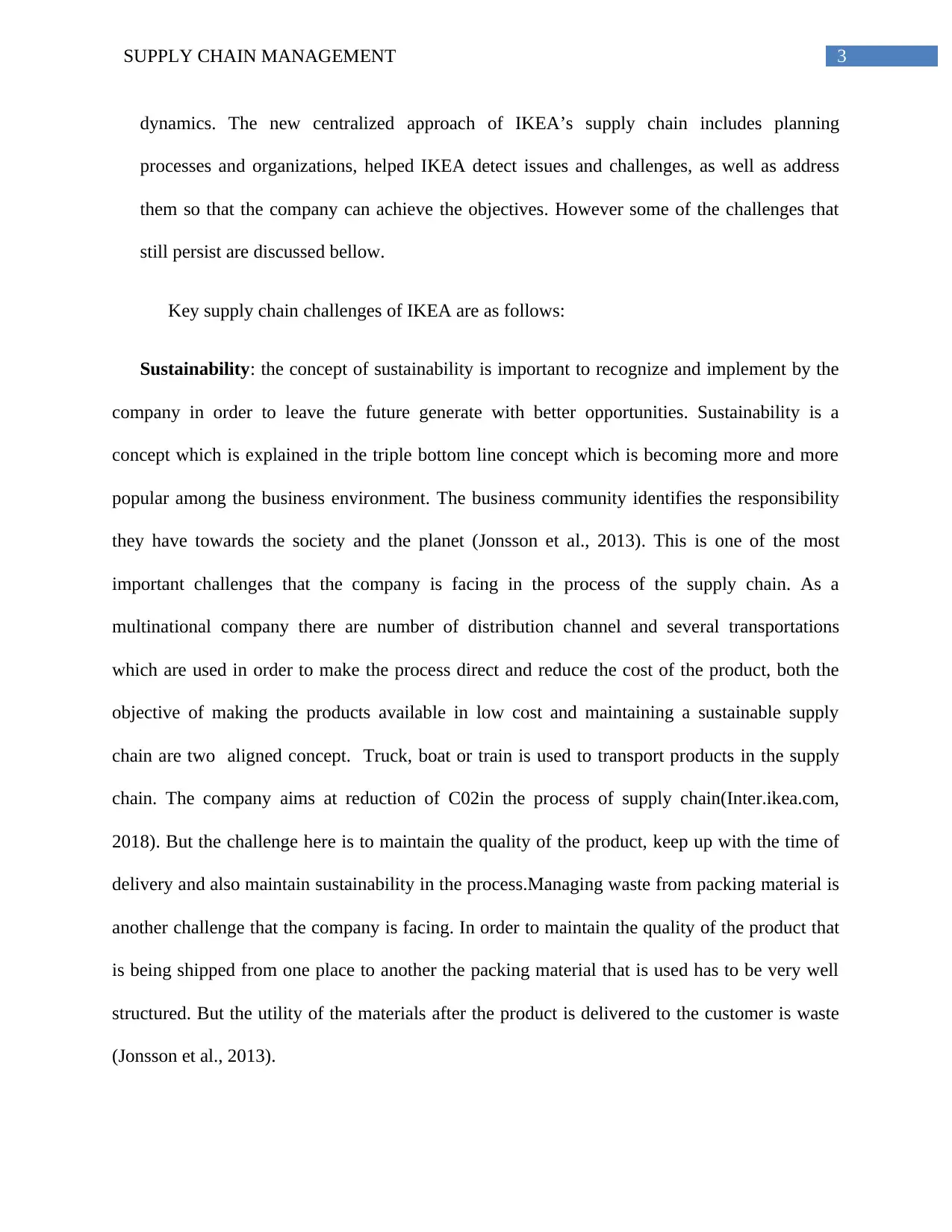
3SUPPLY CHAIN MANAGEMENT
dynamics. The new centralized approach of IKEA’s supply chain includes planning
processes and organizations, helped IKEA detect issues and challenges, as well as address
them so that the company can achieve the objectives. However some of the challenges that
still persist are discussed bellow.
Key supply chain challenges of IKEA are as follows:
Sustainability: the concept of sustainability is important to recognize and implement by the
company in order to leave the future generate with better opportunities. Sustainability is a
concept which is explained in the triple bottom line concept which is becoming more and more
popular among the business environment. The business community identifies the responsibility
they have towards the society and the planet (Jonsson et al., 2013). This is one of the most
important challenges that the company is facing in the process of the supply chain. As a
multinational company there are number of distribution channel and several transportations
which are used in order to make the process direct and reduce the cost of the product, both the
objective of making the products available in low cost and maintaining a sustainable supply
chain are two aligned concept. Truck, boat or train is used to transport products in the supply
chain. The company aims at reduction of C02in the process of supply chain(Inter.ikea.com,
2018). But the challenge here is to maintain the quality of the product, keep up with the time of
delivery and also maintain sustainability in the process.Managing waste from packing material is
another challenge that the company is facing. In order to maintain the quality of the product that
is being shipped from one place to another the packing material that is used has to be very well
structured. But the utility of the materials after the product is delivered to the customer is waste
(Jonsson et al., 2013).
dynamics. The new centralized approach of IKEA’s supply chain includes planning
processes and organizations, helped IKEA detect issues and challenges, as well as address
them so that the company can achieve the objectives. However some of the challenges that
still persist are discussed bellow.
Key supply chain challenges of IKEA are as follows:
Sustainability: the concept of sustainability is important to recognize and implement by the
company in order to leave the future generate with better opportunities. Sustainability is a
concept which is explained in the triple bottom line concept which is becoming more and more
popular among the business environment. The business community identifies the responsibility
they have towards the society and the planet (Jonsson et al., 2013). This is one of the most
important challenges that the company is facing in the process of the supply chain. As a
multinational company there are number of distribution channel and several transportations
which are used in order to make the process direct and reduce the cost of the product, both the
objective of making the products available in low cost and maintaining a sustainable supply
chain are two aligned concept. Truck, boat or train is used to transport products in the supply
chain. The company aims at reduction of C02in the process of supply chain(Inter.ikea.com,
2018). But the challenge here is to maintain the quality of the product, keep up with the time of
delivery and also maintain sustainability in the process.Managing waste from packing material is
another challenge that the company is facing. In order to maintain the quality of the product that
is being shipped from one place to another the packing material that is used has to be very well
structured. But the utility of the materials after the product is delivered to the customer is waste
(Jonsson et al., 2013).
Paraphrase This Document
Need a fresh take? Get an instant paraphrase of this document with our AI Paraphraser
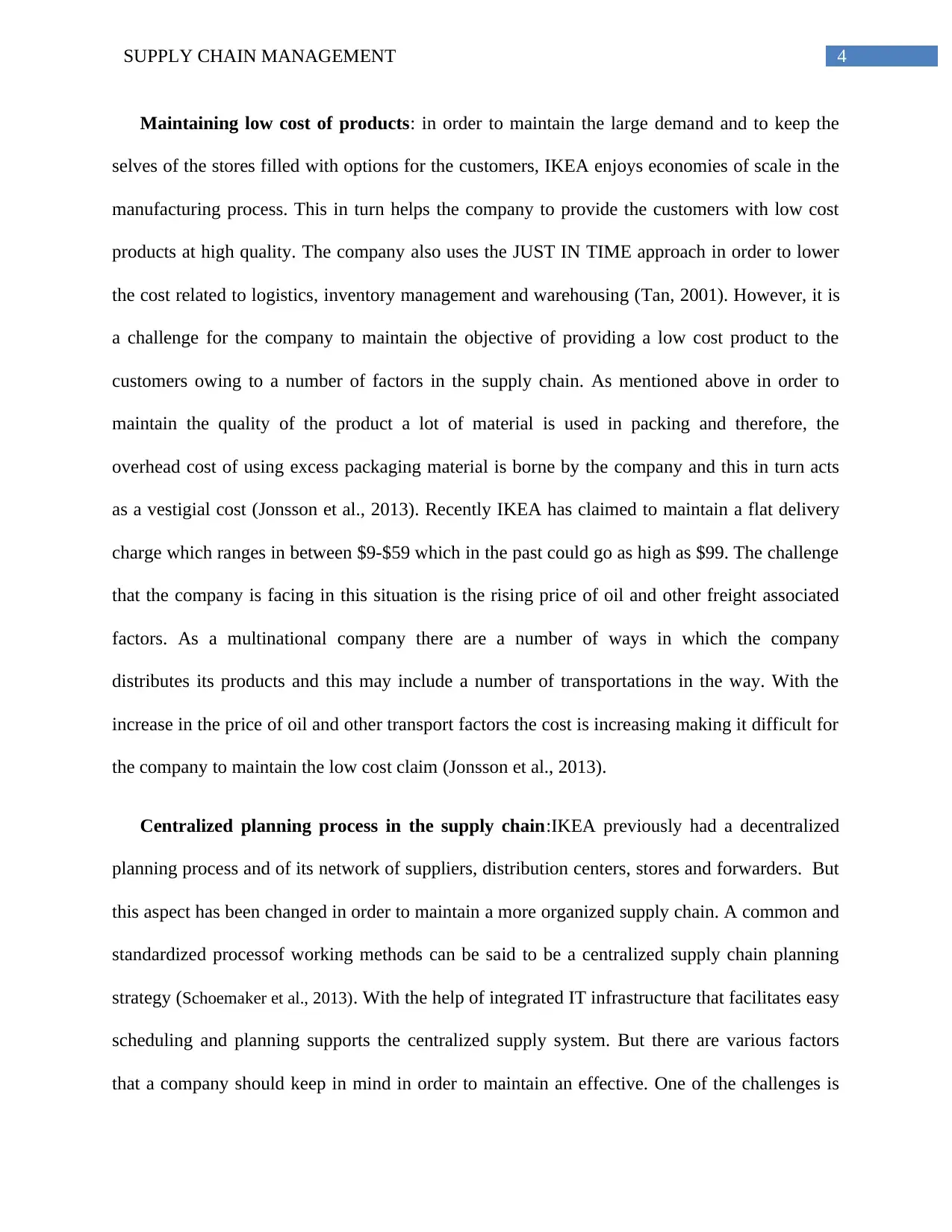
4SUPPLY CHAIN MANAGEMENT
Maintaining low cost of products: in order to maintain the large demand and to keep the
selves of the stores filled with options for the customers, IKEA enjoys economies of scale in the
manufacturing process. This in turn helps the company to provide the customers with low cost
products at high quality. The company also uses the JUST IN TIME approach in order to lower
the cost related to logistics, inventory management and warehousing (Tan, 2001). However, it is
a challenge for the company to maintain the objective of providing a low cost product to the
customers owing to a number of factors in the supply chain. As mentioned above in order to
maintain the quality of the product a lot of material is used in packing and therefore, the
overhead cost of using excess packaging material is borne by the company and this in turn acts
as a vestigial cost (Jonsson et al., 2013). Recently IKEA has claimed to maintain a flat delivery
charge which ranges in between $9-$59 which in the past could go as high as $99. The challenge
that the company is facing in this situation is the rising price of oil and other freight associated
factors. As a multinational company there are a number of ways in which the company
distributes its products and this may include a number of transportations in the way. With the
increase in the price of oil and other transport factors the cost is increasing making it difficult for
the company to maintain the low cost claim (Jonsson et al., 2013).
Centralized planning process in the supply chain:IKEA previously had a decentralized
planning process and of its network of suppliers, distribution centers, stores and forwarders. But
this aspect has been changed in order to maintain a more organized supply chain. A common and
standardized processof working methods can be said to be a centralized supply chain planning
strategy (Schoemaker et al., 2013). With the help of integrated IT infrastructure that facilitates easy
scheduling and planning supports the centralized supply system. But there are various factors
that a company should keep in mind in order to maintain an effective. One of the challenges is
Maintaining low cost of products: in order to maintain the large demand and to keep the
selves of the stores filled with options for the customers, IKEA enjoys economies of scale in the
manufacturing process. This in turn helps the company to provide the customers with low cost
products at high quality. The company also uses the JUST IN TIME approach in order to lower
the cost related to logistics, inventory management and warehousing (Tan, 2001). However, it is
a challenge for the company to maintain the objective of providing a low cost product to the
customers owing to a number of factors in the supply chain. As mentioned above in order to
maintain the quality of the product a lot of material is used in packing and therefore, the
overhead cost of using excess packaging material is borne by the company and this in turn acts
as a vestigial cost (Jonsson et al., 2013). Recently IKEA has claimed to maintain a flat delivery
charge which ranges in between $9-$59 which in the past could go as high as $99. The challenge
that the company is facing in this situation is the rising price of oil and other freight associated
factors. As a multinational company there are a number of ways in which the company
distributes its products and this may include a number of transportations in the way. With the
increase in the price of oil and other transport factors the cost is increasing making it difficult for
the company to maintain the low cost claim (Jonsson et al., 2013).
Centralized planning process in the supply chain:IKEA previously had a decentralized
planning process and of its network of suppliers, distribution centers, stores and forwarders. But
this aspect has been changed in order to maintain a more organized supply chain. A common and
standardized processof working methods can be said to be a centralized supply chain planning
strategy (Schoemaker et al., 2013). With the help of integrated IT infrastructure that facilitates easy
scheduling and planning supports the centralized supply system. But there are various factors
that a company should keep in mind in order to maintain an effective. One of the challenges is
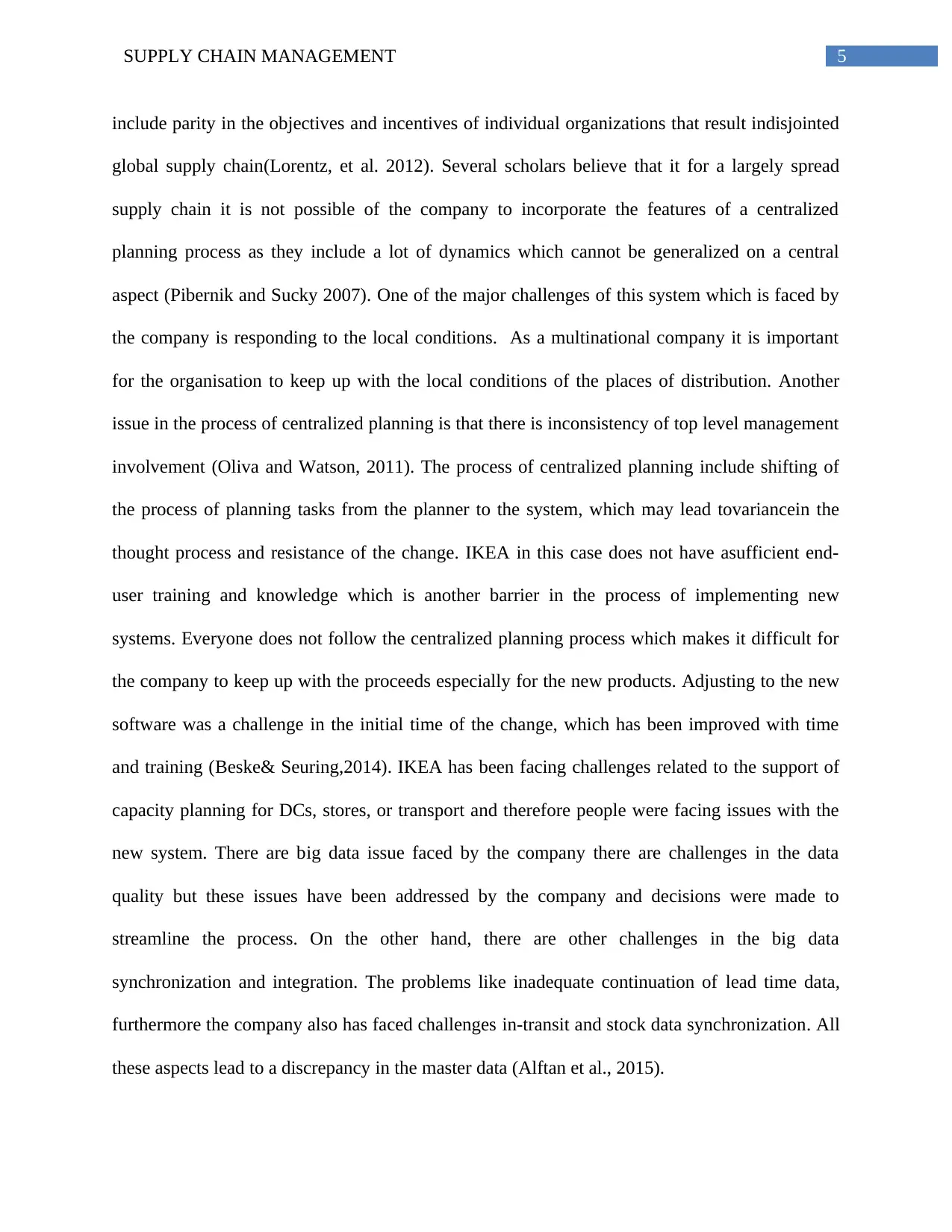
5SUPPLY CHAIN MANAGEMENT
include parity in the objectives and incentives of individual organizations that result indisjointed
global supply chain(Lorentz, et al. 2012). Several scholars believe that it for a largely spread
supply chain it is not possible of the company to incorporate the features of a centralized
planning process as they include a lot of dynamics which cannot be generalized on a central
aspect (Pibernik and Sucky 2007). One of the major challenges of this system which is faced by
the company is responding to the local conditions. As a multinational company it is important
for the organisation to keep up with the local conditions of the places of distribution. Another
issue in the process of centralized planning is that there is inconsistency of top level management
involvement (Oliva and Watson, 2011). The process of centralized planning include shifting of
the process of planning tasks from the planner to the system, which may lead tovariancein the
thought process and resistance of the change. IKEA in this case does not have asufficient end-
user training and knowledge which is another barrier in the process of implementing new
systems. Everyone does not follow the centralized planning process which makes it difficult for
the company to keep up with the proceeds especially for the new products. Adjusting to the new
software was a challenge in the initial time of the change, which has been improved with time
and training (Beske& Seuring,2014). IKEA has been facing challenges related to the support of
capacity planning for DCs, stores, or transport and therefore people were facing issues with the
new system. There are big data issue faced by the company there are challenges in the data
quality but these issues have been addressed by the company and decisions were made to
streamline the process. On the other hand, there are other challenges in the big data
synchronization and integration. The problems like inadequate continuation of lead time data,
furthermore the company also has faced challenges in-transit and stock data synchronization. All
these aspects lead to a discrepancy in the master data (Alftan et al., 2015).
include parity in the objectives and incentives of individual organizations that result indisjointed
global supply chain(Lorentz, et al. 2012). Several scholars believe that it for a largely spread
supply chain it is not possible of the company to incorporate the features of a centralized
planning process as they include a lot of dynamics which cannot be generalized on a central
aspect (Pibernik and Sucky 2007). One of the major challenges of this system which is faced by
the company is responding to the local conditions. As a multinational company it is important
for the organisation to keep up with the local conditions of the places of distribution. Another
issue in the process of centralized planning is that there is inconsistency of top level management
involvement (Oliva and Watson, 2011). The process of centralized planning include shifting of
the process of planning tasks from the planner to the system, which may lead tovariancein the
thought process and resistance of the change. IKEA in this case does not have asufficient end-
user training and knowledge which is another barrier in the process of implementing new
systems. Everyone does not follow the centralized planning process which makes it difficult for
the company to keep up with the proceeds especially for the new products. Adjusting to the new
software was a challenge in the initial time of the change, which has been improved with time
and training (Beske& Seuring,2014). IKEA has been facing challenges related to the support of
capacity planning for DCs, stores, or transport and therefore people were facing issues with the
new system. There are big data issue faced by the company there are challenges in the data
quality but these issues have been addressed by the company and decisions were made to
streamline the process. On the other hand, there are other challenges in the big data
synchronization and integration. The problems like inadequate continuation of lead time data,
furthermore the company also has faced challenges in-transit and stock data synchronization. All
these aspects lead to a discrepancy in the master data (Alftan et al., 2015).
⊘ This is a preview!⊘
Do you want full access?
Subscribe today to unlock all pages.

Trusted by 1+ million students worldwide
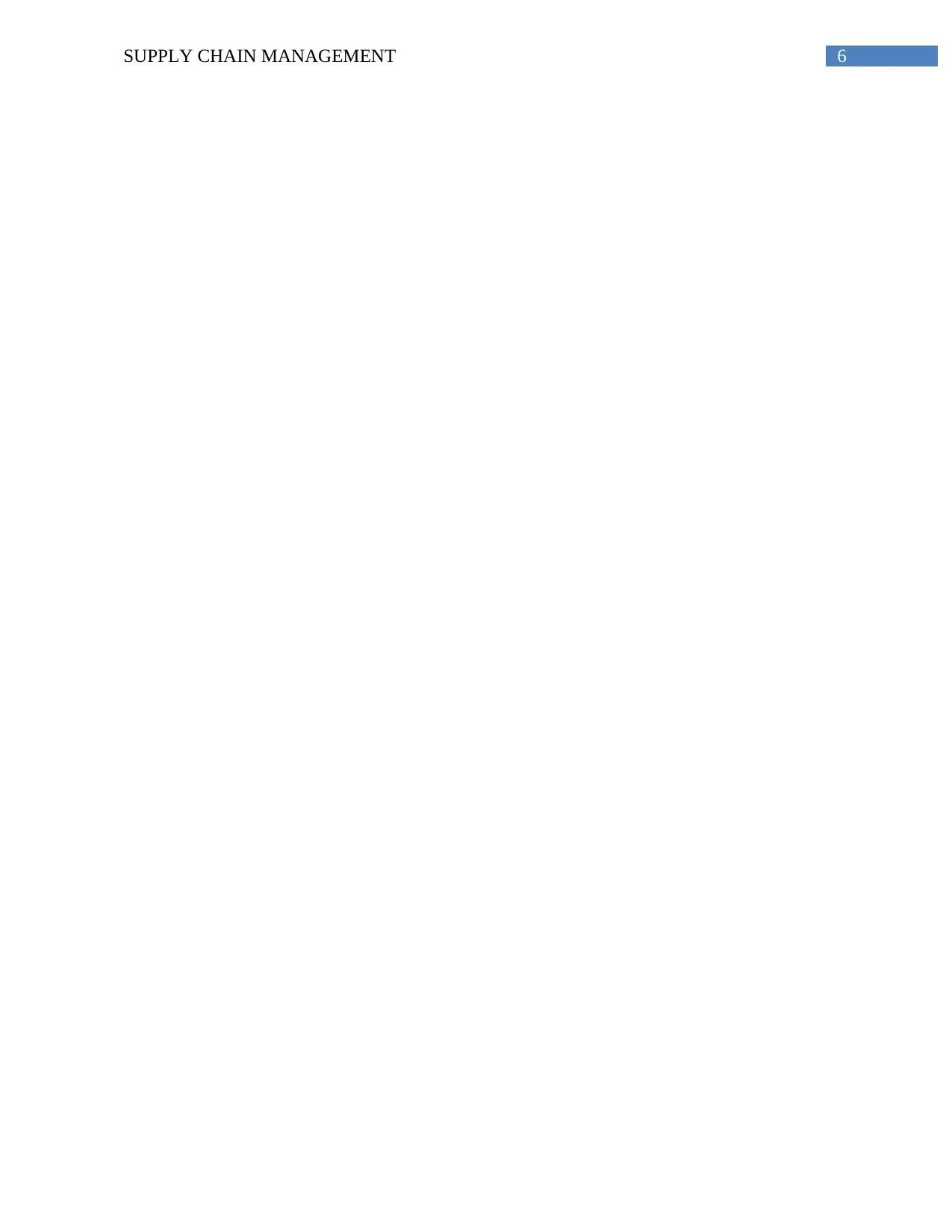
6SUPPLY CHAIN MANAGEMENT
Paraphrase This Document
Need a fresh take? Get an instant paraphrase of this document with our AI Paraphraser
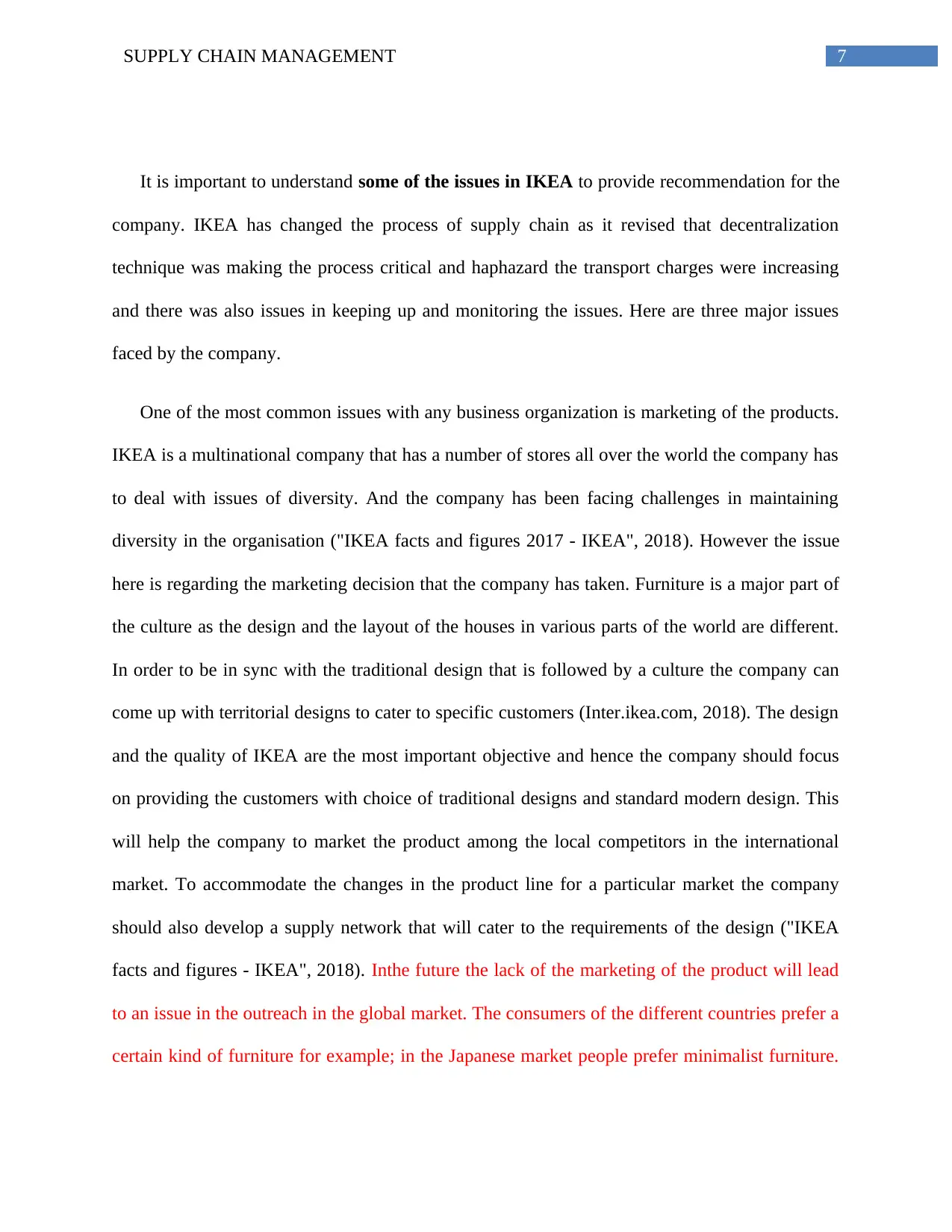
7SUPPLY CHAIN MANAGEMENT
It is important to understand some of the issues in IKEA to provide recommendation for the
company. IKEA has changed the process of supply chain as it revised that decentralization
technique was making the process critical and haphazard the transport charges were increasing
and there was also issues in keeping up and monitoring the issues. Here are three major issues
faced by the company.
One of the most common issues with any business organization is marketing of the products.
IKEA is a multinational company that has a number of stores all over the world the company has
to deal with issues of diversity. And the company has been facing challenges in maintaining
diversity in the organisation ("IKEA facts and figures 2017 - IKEA", 2018). However the issue
here is regarding the marketing decision that the company has taken. Furniture is a major part of
the culture as the design and the layout of the houses in various parts of the world are different.
In order to be in sync with the traditional design that is followed by a culture the company can
come up with territorial designs to cater to specific customers (Inter.ikea.com, 2018). The design
and the quality of IKEA are the most important objective and hence the company should focus
on providing the customers with choice of traditional designs and standard modern design. This
will help the company to market the product among the local competitors in the international
market. To accommodate the changes in the product line for a particular market the company
should also develop a supply network that will cater to the requirements of the design ("IKEA
facts and figures - IKEA", 2018). Inthe future the lack of the marketing of the product will lead
to an issue in the outreach in the global market. The consumers of the different countries prefer a
certain kind of furniture for example; in the Japanese market people prefer minimalist furniture.
It is important to understand some of the issues in IKEA to provide recommendation for the
company. IKEA has changed the process of supply chain as it revised that decentralization
technique was making the process critical and haphazard the transport charges were increasing
and there was also issues in keeping up and monitoring the issues. Here are three major issues
faced by the company.
One of the most common issues with any business organization is marketing of the products.
IKEA is a multinational company that has a number of stores all over the world the company has
to deal with issues of diversity. And the company has been facing challenges in maintaining
diversity in the organisation ("IKEA facts and figures 2017 - IKEA", 2018). However the issue
here is regarding the marketing decision that the company has taken. Furniture is a major part of
the culture as the design and the layout of the houses in various parts of the world are different.
In order to be in sync with the traditional design that is followed by a culture the company can
come up with territorial designs to cater to specific customers (Inter.ikea.com, 2018). The design
and the quality of IKEA are the most important objective and hence the company should focus
on providing the customers with choice of traditional designs and standard modern design. This
will help the company to market the product among the local competitors in the international
market. To accommodate the changes in the product line for a particular market the company
should also develop a supply network that will cater to the requirements of the design ("IKEA
facts and figures - IKEA", 2018). Inthe future the lack of the marketing of the product will lead
to an issue in the outreach in the global market. The consumers of the different countries prefer a
certain kind of furniture for example; in the Japanese market people prefer minimalist furniture.

8SUPPLY CHAIN MANAGEMENT
The furniture apart from being cost friendly also has to be varying in the designs to meet the
needs of the people.
To mitigate the aforesaid issues the company has to focus of various measures. Firstly, it
needs to understand the varying requirement of the consumers depending on the target market.
Secondly, it has to make sure how those requirements can be met in a cost effective way.
Thirdly, the company has to employ the local designers to meet the needs of the different people.
Expansion in the south Asian region especially in India is another major issue or challenge
that the company is facing. This barrier in the process of expansion is a direct cause of the one of
the most important factors of the external environment, political factors (CHEW, 2016). The
government of India has a Make In India campaign as a part of their internal strategy of
encouraging trade and business in the country, the government is contradicting the business
function in this region as the clause of operation is procuring 30 percent of inventory form the
country. Indi is a lucrative market to expand gives the circumstances and the prediction of the
global market. In India English is used as an official language which bridges the gap in between
the communication among the business function and the customers. But the contradiction of
interest in between the company and the government of India is an issue that the company is still
trying to overcome (CHEW, 2016). This can prove to be one of the major challenges in the
growth and development of IKEA in the country as outsourcing the business means add-on costs
to the company. The local legislations will also have issues regarding the labour laws in the
expansion of the country.
The addressing of the issues will require a focus on certain points. Firstly the local laws and
the legislations have to be understood to address the problem. Secondly, the organizations has to
The furniture apart from being cost friendly also has to be varying in the designs to meet the
needs of the people.
To mitigate the aforesaid issues the company has to focus of various measures. Firstly, it
needs to understand the varying requirement of the consumers depending on the target market.
Secondly, it has to make sure how those requirements can be met in a cost effective way.
Thirdly, the company has to employ the local designers to meet the needs of the different people.
Expansion in the south Asian region especially in India is another major issue or challenge
that the company is facing. This barrier in the process of expansion is a direct cause of the one of
the most important factors of the external environment, political factors (CHEW, 2016). The
government of India has a Make In India campaign as a part of their internal strategy of
encouraging trade and business in the country, the government is contradicting the business
function in this region as the clause of operation is procuring 30 percent of inventory form the
country. Indi is a lucrative market to expand gives the circumstances and the prediction of the
global market. In India English is used as an official language which bridges the gap in between
the communication among the business function and the customers. But the contradiction of
interest in between the company and the government of India is an issue that the company is still
trying to overcome (CHEW, 2016). This can prove to be one of the major challenges in the
growth and development of IKEA in the country as outsourcing the business means add-on costs
to the company. The local legislations will also have issues regarding the labour laws in the
expansion of the country.
The addressing of the issues will require a focus on certain points. Firstly the local laws and
the legislations have to be understood to address the problem. Secondly, the organizations has to
⊘ This is a preview!⊘
Do you want full access?
Subscribe today to unlock all pages.

Trusted by 1+ million students worldwide
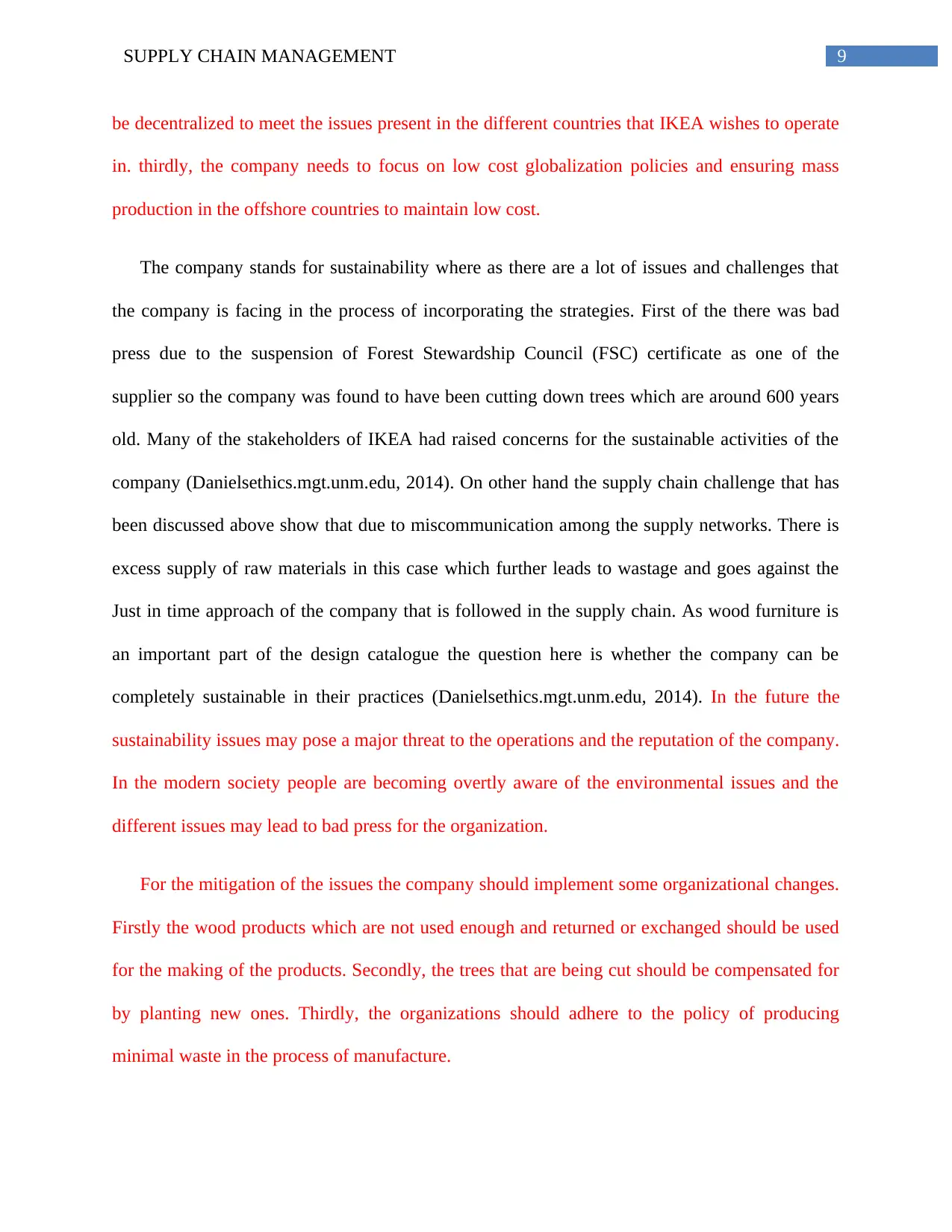
9SUPPLY CHAIN MANAGEMENT
be decentralized to meet the issues present in the different countries that IKEA wishes to operate
in. thirdly, the company needs to focus on low cost globalization policies and ensuring mass
production in the offshore countries to maintain low cost.
The company stands for sustainability where as there are a lot of issues and challenges that
the company is facing in the process of incorporating the strategies. First of the there was bad
press due to the suspension of Forest Stewardship Council (FSC) certificate as one of the
supplier so the company was found to have been cutting down trees which are around 600 years
old. Many of the stakeholders of IKEA had raised concerns for the sustainable activities of the
company (Danielsethics.mgt.unm.edu, 2014). On other hand the supply chain challenge that has
been discussed above show that due to miscommunication among the supply networks. There is
excess supply of raw materials in this case which further leads to wastage and goes against the
Just in time approach of the company that is followed in the supply chain. As wood furniture is
an important part of the design catalogue the question here is whether the company can be
completely sustainable in their practices (Danielsethics.mgt.unm.edu, 2014). In the future the
sustainability issues may pose a major threat to the operations and the reputation of the company.
In the modern society people are becoming overtly aware of the environmental issues and the
different issues may lead to bad press for the organization.
For the mitigation of the issues the company should implement some organizational changes.
Firstly the wood products which are not used enough and returned or exchanged should be used
for the making of the products. Secondly, the trees that are being cut should be compensated for
by planting new ones. Thirdly, the organizations should adhere to the policy of producing
minimal waste in the process of manufacture.
be decentralized to meet the issues present in the different countries that IKEA wishes to operate
in. thirdly, the company needs to focus on low cost globalization policies and ensuring mass
production in the offshore countries to maintain low cost.
The company stands for sustainability where as there are a lot of issues and challenges that
the company is facing in the process of incorporating the strategies. First of the there was bad
press due to the suspension of Forest Stewardship Council (FSC) certificate as one of the
supplier so the company was found to have been cutting down trees which are around 600 years
old. Many of the stakeholders of IKEA had raised concerns for the sustainable activities of the
company (Danielsethics.mgt.unm.edu, 2014). On other hand the supply chain challenge that has
been discussed above show that due to miscommunication among the supply networks. There is
excess supply of raw materials in this case which further leads to wastage and goes against the
Just in time approach of the company that is followed in the supply chain. As wood furniture is
an important part of the design catalogue the question here is whether the company can be
completely sustainable in their practices (Danielsethics.mgt.unm.edu, 2014). In the future the
sustainability issues may pose a major threat to the operations and the reputation of the company.
In the modern society people are becoming overtly aware of the environmental issues and the
different issues may lead to bad press for the organization.
For the mitigation of the issues the company should implement some organizational changes.
Firstly the wood products which are not used enough and returned or exchanged should be used
for the making of the products. Secondly, the trees that are being cut should be compensated for
by planting new ones. Thirdly, the organizations should adhere to the policy of producing
minimal waste in the process of manufacture.
Paraphrase This Document
Need a fresh take? Get an instant paraphrase of this document with our AI Paraphraser

10SUPPLY CHAIN MANAGEMENT
The company can overcome some of the challenges by identifying the opportunities that
they have and the recommendations that will be followed.
Based on the long-term relationship with the suppliers that are already associated with the
company this provides better opportunities in the market to build a better network in the
growing supply chain.
The company also has opportunity to invest in outsourcing of some of the challenges that
they are facing in the business function. Like the diverse planners with diverse knowledge.
There is a growing need for sustainable products among the customers which can be
aligned with the sustainable activities of the company.
The company also has the resources to incorporate in a detailed learning and training
program in order to improve the business operations. The people have a scope to learn and to
improve the knowledge regarding the new process and system in the global market that has been
incorporated by the management of the company.
The weakness of IKEA’s supply chain has been addressed in Assignment 1, here are
some of the recommendations that the company can incorporate in order to overcome the
weaknesses.
The first weakness that has been pointed out is the lack of co-ordination among the
suppliers and the company. Here the issue can be aligned with the centralized supply chain
challenges of big data management can be aligned. The company has to incorporate training and
skill development for the people to ensure efficient communication and to co-ordinate better with
not only the suppliers but also with other networks in the process of the supply chain.
The company can overcome some of the challenges by identifying the opportunities that
they have and the recommendations that will be followed.
Based on the long-term relationship with the suppliers that are already associated with the
company this provides better opportunities in the market to build a better network in the
growing supply chain.
The company also has opportunity to invest in outsourcing of some of the challenges that
they are facing in the business function. Like the diverse planners with diverse knowledge.
There is a growing need for sustainable products among the customers which can be
aligned with the sustainable activities of the company.
The company also has the resources to incorporate in a detailed learning and training
program in order to improve the business operations. The people have a scope to learn and to
improve the knowledge regarding the new process and system in the global market that has been
incorporated by the management of the company.
The weakness of IKEA’s supply chain has been addressed in Assignment 1, here are
some of the recommendations that the company can incorporate in order to overcome the
weaknesses.
The first weakness that has been pointed out is the lack of co-ordination among the
suppliers and the company. Here the issue can be aligned with the centralized supply chain
challenges of big data management can be aligned. The company has to incorporate training and
skill development for the people to ensure efficient communication and to co-ordinate better with
not only the suppliers but also with other networks in the process of the supply chain.
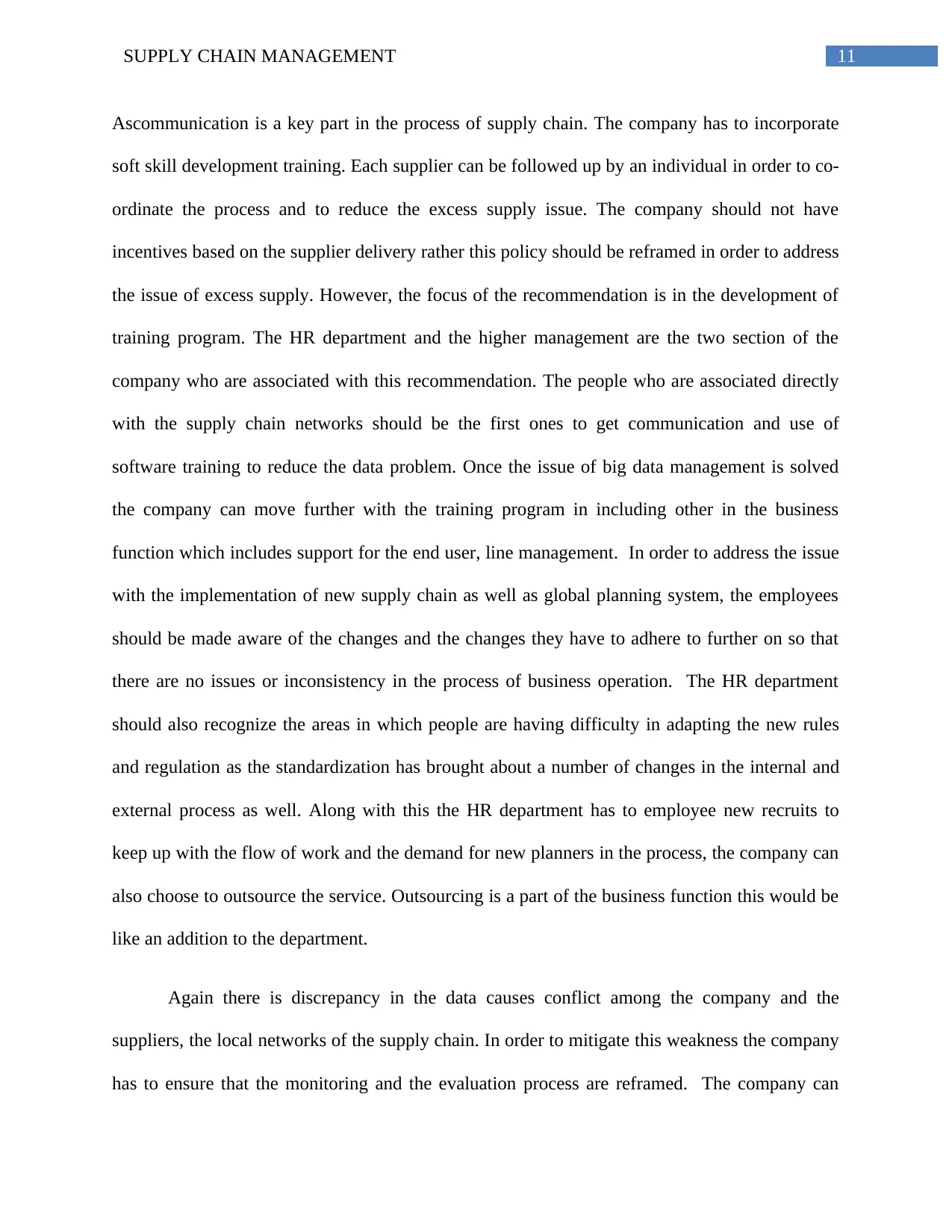
11SUPPLY CHAIN MANAGEMENT
Ascommunication is a key part in the process of supply chain. The company has to incorporate
soft skill development training. Each supplier can be followed up by an individual in order to co-
ordinate the process and to reduce the excess supply issue. The company should not have
incentives based on the supplier delivery rather this policy should be reframed in order to address
the issue of excess supply. However, the focus of the recommendation is in the development of
training program. The HR department and the higher management are the two section of the
company who are associated with this recommendation. The people who are associated directly
with the supply chain networks should be the first ones to get communication and use of
software training to reduce the data problem. Once the issue of big data management is solved
the company can move further with the training program in including other in the business
function which includes support for the end user, line management. In order to address the issue
with the implementation of new supply chain as well as global planning system, the employees
should be made aware of the changes and the changes they have to adhere to further on so that
there are no issues or inconsistency in the process of business operation. The HR department
should also recognize the areas in which people are having difficulty in adapting the new rules
and regulation as the standardization has brought about a number of changes in the internal and
external process as well. Along with this the HR department has to employee new recruits to
keep up with the flow of work and the demand for new planners in the process, the company can
also choose to outsource the service. Outsourcing is a part of the business function this would be
like an addition to the department.
Again there is discrepancy in the data causes conflict among the company and the
suppliers, the local networks of the supply chain. In order to mitigate this weakness the company
has to ensure that the monitoring and the evaluation process are reframed. The company can
Ascommunication is a key part in the process of supply chain. The company has to incorporate
soft skill development training. Each supplier can be followed up by an individual in order to co-
ordinate the process and to reduce the excess supply issue. The company should not have
incentives based on the supplier delivery rather this policy should be reframed in order to address
the issue of excess supply. However, the focus of the recommendation is in the development of
training program. The HR department and the higher management are the two section of the
company who are associated with this recommendation. The people who are associated directly
with the supply chain networks should be the first ones to get communication and use of
software training to reduce the data problem. Once the issue of big data management is solved
the company can move further with the training program in including other in the business
function which includes support for the end user, line management. In order to address the issue
with the implementation of new supply chain as well as global planning system, the employees
should be made aware of the changes and the changes they have to adhere to further on so that
there are no issues or inconsistency in the process of business operation. The HR department
should also recognize the areas in which people are having difficulty in adapting the new rules
and regulation as the standardization has brought about a number of changes in the internal and
external process as well. Along with this the HR department has to employee new recruits to
keep up with the flow of work and the demand for new planners in the process, the company can
also choose to outsource the service. Outsourcing is a part of the business function this would be
like an addition to the department.
Again there is discrepancy in the data causes conflict among the company and the
suppliers, the local networks of the supply chain. In order to mitigate this weakness the company
has to ensure that the monitoring and the evaluation process are reframed. The company can
⊘ This is a preview!⊘
Do you want full access?
Subscribe today to unlock all pages.

Trusted by 1+ million students worldwide
1 out of 17
Related Documents
Your All-in-One AI-Powered Toolkit for Academic Success.
+13062052269
info@desklib.com
Available 24*7 on WhatsApp / Email
![[object Object]](/_next/static/media/star-bottom.7253800d.svg)
Unlock your academic potential
Copyright © 2020–2025 A2Z Services. All Rights Reserved. Developed and managed by ZUCOL.





